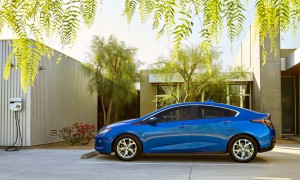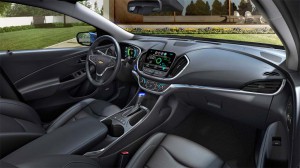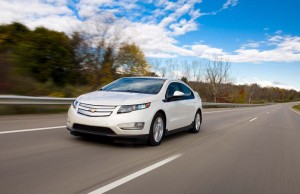The second-generation Chevrolet Volt will deliver 40% more range in battery mode than the original version of the plug-in hybrid, the maker announced today.
At 53 miles per charge, the compact sedan will permit buyers to commute or run even more errands without using any gas, General Motors officials have suggested. They also hope to increase the appeal of the 2016 Chevrolet Volt by offering better performance and more interior space, the new plug-in now capable of seating five, rather than four like the original model.
“We listened to our customers,” Volt chief engineer Andrew Farah said ahead of a news conference at the annual Management Briefing Seminars, in Traverse City, Michigan. “They were very clear when they told us that they wanted more range, and a fun driving experience behind the wheel. We are confident that the 2016 Volt delivers both.”
The Volt itself needs a bit of a boost. After a strong start when it went on sale in late 2010, the “extended-range electric vehicle” has steadily lost market momentum. Through the end of July, sales of 6,935 were off 34.8% compared to the same period in 2014 – though Volt outsold the Nissan Leaf battery-electric vehicle last month for the first time in several years.
At one point, Chevrolet was hoping to sell as many as 60,000 of its plug-ins annually, a figure that was to include the Opel Ampera, as well as the Volt. The European model has been dropped due to weak demand.
(EVs will go mainstream — eventually — says Nissan’s Ghosn. Click Here for the story.)
Chevy has taken a number of steps hoping to charge up demand for the Volt, including cutting its price tag. The current MSRP is $35,170 – not including incentives – down from the original $40,000.
Part of the problem is that battery-based vehicles, in general, have lost momentum at a time when fuel prices have tumbled sharply. Through July, total plug-in and battery-electric sales in the U.S. totaled just 60,964, down from 67,533, according to InsideEVs.com, a website that tracks alternative vehicle technology.
Analysts contend that manufacturers have to deal with several key challenges, including range, performance and price, as well as both a lack of a charging infrastructure – and the time it takes to recharge.
Chevy is hoping to address several of those challenges with the 2016 Volt. Not only is it getting 53 miles per charge, compared to 38 for the old plug-in, but the new model will start at $33,995, a $1,200 price reduction compared to the 2015 Volt. Work in the $7,500 federal tax credit and that slips to $26,495. A number of states offer their own incentives – though several are now charging higher registration fees for battery cars to compensate for lower annual fuel taxes.
The Volt underwent a major redesign for 2016. It gets a more sportier exterior and a roomier, more plush interior that now seats five.
To pull that off, GM switched to a smaller, more energy-dense battery that doesn’t need to take up the center of the passenger compartment like the old, T-shaped pack. The smaller pack is one reason the 2016 Chevrolet Volt is 100 pounds lighter than the old model.
The downsized battery powers an updated hybrid drivetrain that is paired with a new, 1.5-liter inline-four gas engine. The powertrain now makes a maximum 149 horsepower, with torque jumping to 294 pound-feet. The development team was able to trim a half-second off the new Volt’s 0 to 60 launch time, now an estimated 8.4 seconds.
(When “Insane Mode” isn’t enough. Tesla adding new “Luuudicrous Mode” for Model S. Click Here for more.)
The 2016 Chevrolet Volt has a combined range of 420 miles – up from 380 with the old model – before it has to fill up or recharge. The new model is rated at a combined 42 mpg, compared to 37 with the 2015 Volt. The EPA also gives it a 106 MPG-e rating, up from 102 before.
According to Chevy’s estimates, 90% of the trips Volt owners make will now be run entirely on battery power as long as the vehicle is fully charged. That was around 80% with the outgoing model.
(New California public-private initiative searching for elusive battery breakthroughs. Click Here for more.)




Marketing… when a deficit is now a “feature”. I doubt 90% of commuters could do their daily commute in less than 53 miles round trip. Depending on the cost for electricity it still may not be a good deal even with government incentives paid for by tax payers and auto maker subsidies paid for by higher sticker prices on other non-EV models.
@Jorge,
53 mile round trip for a daily commute is easily do-able for lots of people.
My wife’s round-trip daily commute is only 22 miles.
She’s driving a first gen Chevy Volt, which she loves.
We installed the high-voltage/high-amperage charging station, and she rarely drives on gasoline at all.
Our monthly electricity bill increased around $30 a month, so as a rough guess, I’d say she’s spending around a dollar a day for her daily commute.
Where do you live that you spend more than an hour each day commuting to and from work?
I’d suggest you move someplace else; that’s a complete waste of your heartbeats and your time; both of which you’ll never ever get back.
-john
I have to agree, Jorge, that 53 miles is a good amount of range for a plug-in (but would be way short for a pure BEV). A significant number of the people I know commute far less on a daily basis, though I certainly also know people who travel much further and would have to use at least some gasoline every day. (That assumes they don’t plug in to recharge while at work, something a small number of PHEV and BEV drivers do.)
Paul E.